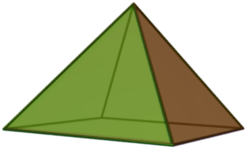You can help expand this article with text translated from the corresponding article in Chinese. (February 2025)Click [show] for important translation instructions.
|
This article needs additional citations for verification .(March 2025) |
In geometry, a pentahedron (pl.: pentahedra) is a polyhedron with five faces or sides. There are no face-transitive polyhedra with five sides, and there are two distinct topological types. Notable polyhedra with regular polygon faces are:
Contents
- Square pyramid with four triangles and one square. [1] Pyramids with any quadrilateral base have the same number of faces.
- Triangular prism with three rectangles and two triangular bases. [1] In the case of a right triangular prism, it is a special case of wedge with connecting parallel edges between triangles; the wedge generally has two triangles and three quadrilateral faces. [2] Topologically, the triangular frustum is the same polyhedron, but the two triangles are different sizes, and the sides are slanted trapezoids.
The pentahedra can be used as space-filling. [3] [4]


